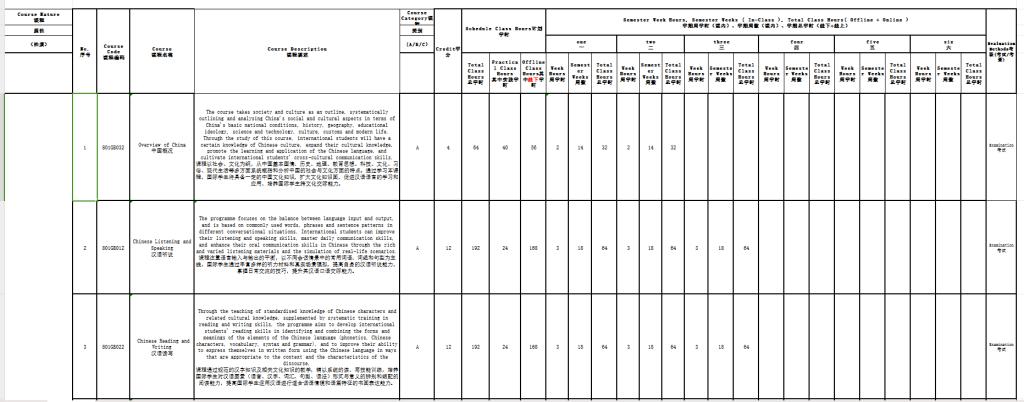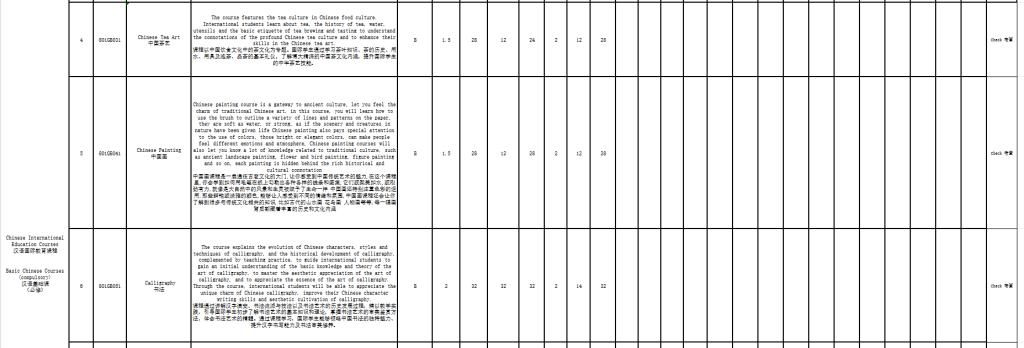
Guangxi Electric Power Vocational and Technical College
Compilation of Professional Talent Training Program of Intelligent Manufacturing Engineering College
Applicable grades: |
International Class 2023 |
Prepared by: |
Xie Xiangqiang |
Editorial Board Members: |
Longtanning, Wei Lianqi, Luo Tianqing Huang Quan, Chen Yuyan and Qin Feng |
|
Secondary College Reviewer: |
Yuhe |
Reviewed by: |
Ribin |
School Reviewer: |
Zhannianyuan |
二〇二四年七月
2023 Level International Talent Training Program for Technical
Specialty of Vitality and Electricity Integration
I. Specialty name and code
Discipline name: Electromechanical integration technology
Discipline Code: 460301
II. Admission Requirements
A learner who graduates from a general high school, secondary vocational school, or equivalent.
III. Years of training
Three years.
IV. Career Orientation
Job Orientation Schedule
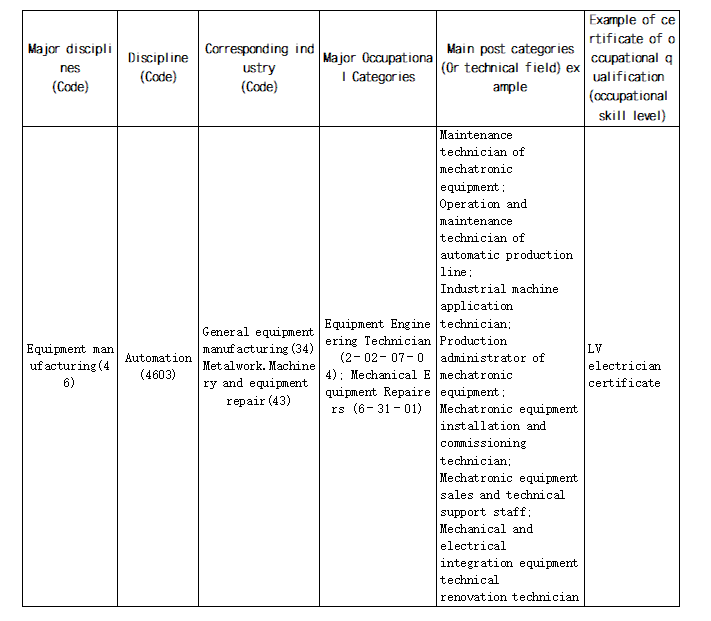
Job Analysis
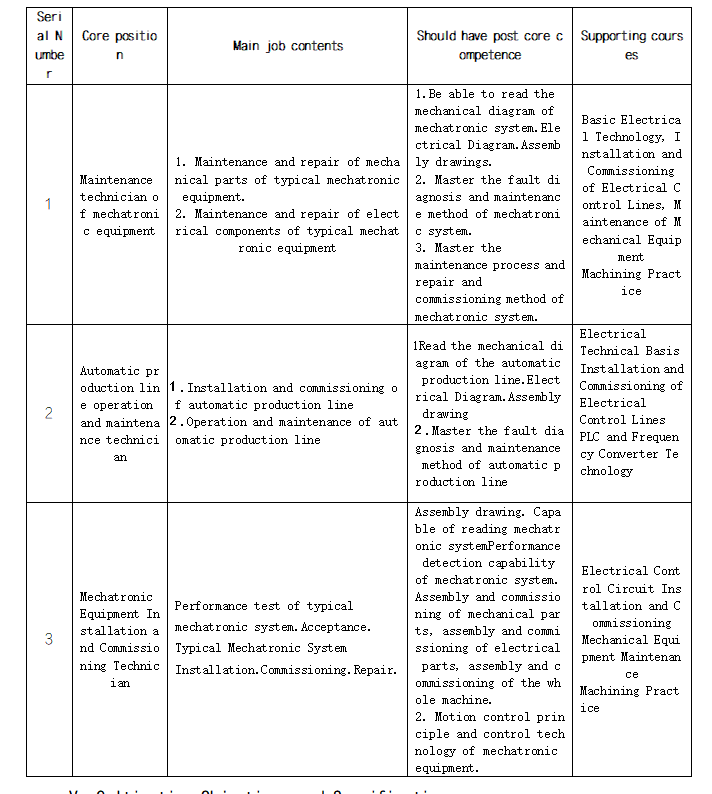
V. Cultivation Objectives and Specifications
1. Cultivation objectives
the all-round development of morality, intelligence, physique, beauty and labor, with certain scientific and cultural level and good humanistic accomplishment.Professional ethics and innovation consciousness, craftsmen's spirit of striving for excellence, strong employment ability and sustainable development ability, mastering the basic knowledge and main technical skills of the specialty, facing the general equipment manufacturing industry, metal products.Equipment engineering technician of machinery and equipment repair industry.Occupational groups such as mechanical equipment repairmen, capable of manufacturing and maintaining mechatronic equipment and.Automatic production line operation and maintenance. Industrial Robot Applications.Installation and commissioning of mechatronic equipment.Multi-functional and innovative high-quality technical and skill talents for sales of mechatronic equipment and technical support for technical transformation of mechatronic equipment.
2. Culture specification and quality standard
Graduates of the major shall meet the following requirements in terms of quality, knowledge and ability.
(1) Quality
①Professional quality: Quality awareness, environmental protection awareness, safety awareness, information literacy, craftsman spirit, innovative thinking, self-management ability, career planning awareness, strong collective awareness and social duties sense.
②Physical and mental quality: Having healthy physique, psychology and sound personality, respecting and loving labor, and having good behavior and hygiene habits.
(2) Knowledge
①Basic knowledge of laws, regulations and professional ethics;
②Basic knowledge of mathematical operation, logical thinking and logical reasoning
③Have basic knowledge of language, information expression, emotion transmission, humanities and arts;
④Have basic knowledge of computer, typical office software, common professional software and common English in the workplace;
⑤Basic knowledge of mechanical engineering such as mechanical drawing, fitter process, engineering materials, mechanical parts, mechanical system, tolerance fit and mechanical maintenance;
⑥Professional theoretical knowledge of electrical control such as electrical process, electronic technology, electric drive, electrical control and electrical maintenance;
⑦It has the theoretical knowledge of mechanical and electrical integration technology such as three-dimensional design of mechanical and electrical products, sensor detection, hydraulic and pneumatic, single chip computer measurement and control, PLC control, frequency conversion speed regulation, industrial interface, industrial configuration, touch screen technology, etc.
⑧Master the installation, commissioning, operation, maintenance and overhaul of typical electromechanical equipment (system) such as auxiliary machine system, motion control, industrial robot, automatic production line and intelligent manufacturing production system of power plant;
⑨Master the basic knowledge of equipment management, quality management and safety management on production site.
(3) Capability
①It has the ability of inquiry learning, lifelong learning, team cooperation, problem analysis and problem solving, innovation consciousness and technical innovation ability.
②Ability to use design manuals, process manuals and network information resources, and the ability to query and use relevant technical data of various disciplines;
③Prepare solutions for installation, commissioning and maintenance of electromechanical system;
④Be able to select and use common instruments, meters and tools, and be able to select the models of mechanical and electrical components correctly for corresponding work tasks.
⑤) Be able to install, commission, maintain and repair the electrical control system;
⑥Capable of installation, commissioning, maintenance and repair of typical mechatronic equipment;
⑦Basic capability for installation, commissioning and maintenance of industrial robot and intelligent manufacturing production system.
VI. Course Setting and Requirements
This course is divided into public basic course and professional course, and the course nature is divided into compulsory course, limited elective course and elective course.
In the first semester, he majored in the basic Chinese language and related general courses. In the 2nd semester, he majored in Chinese Basic, Professional Basic and related general courses. Major courses in the 3rd to 5th semesters can be incorporated into the domestic students' classes. The 6th semester mainly arranges enterprise practice and graduation thesis/design.
(I) Public basic courses
Basic Chinese courses and public basic courses are aimed at strengthening the education of students' cultural quality, professional quality and physical and mental quality. See the following table for details.
Chinese Basic Course and Public Basic Course
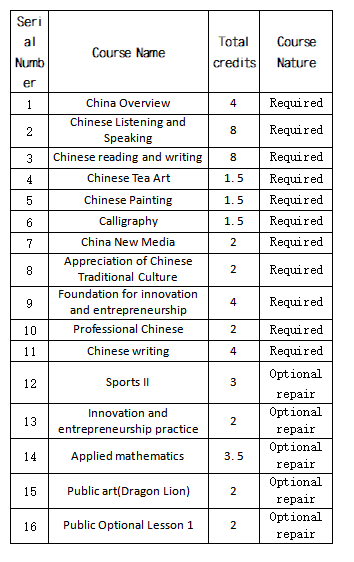
(II) Professional courses
Set up 5 professional courses, 2 theoretical integration courses, 2 practical courses and 1 technical frontier course. See the following table for professional courses.
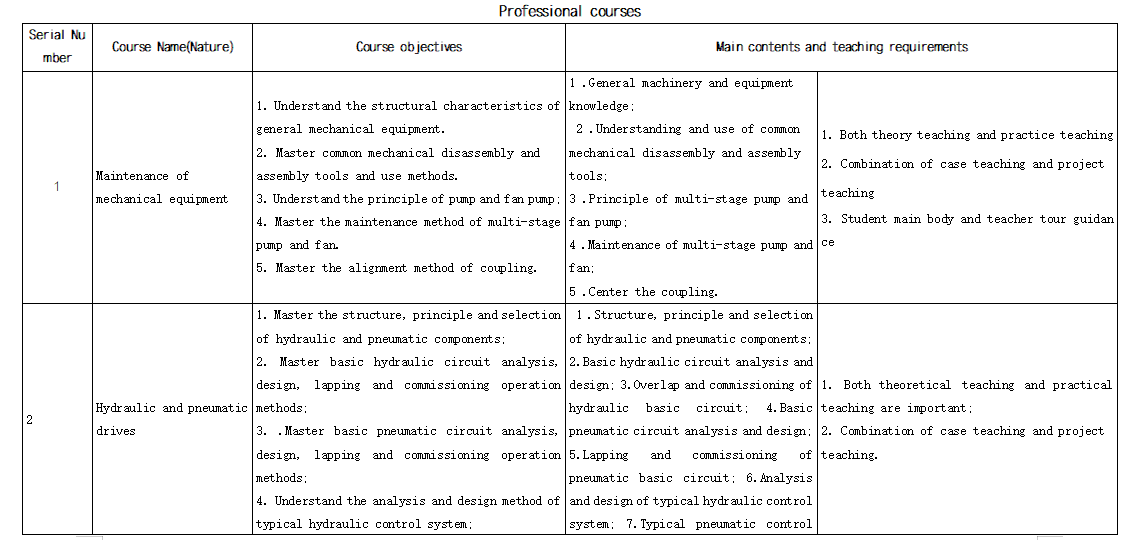
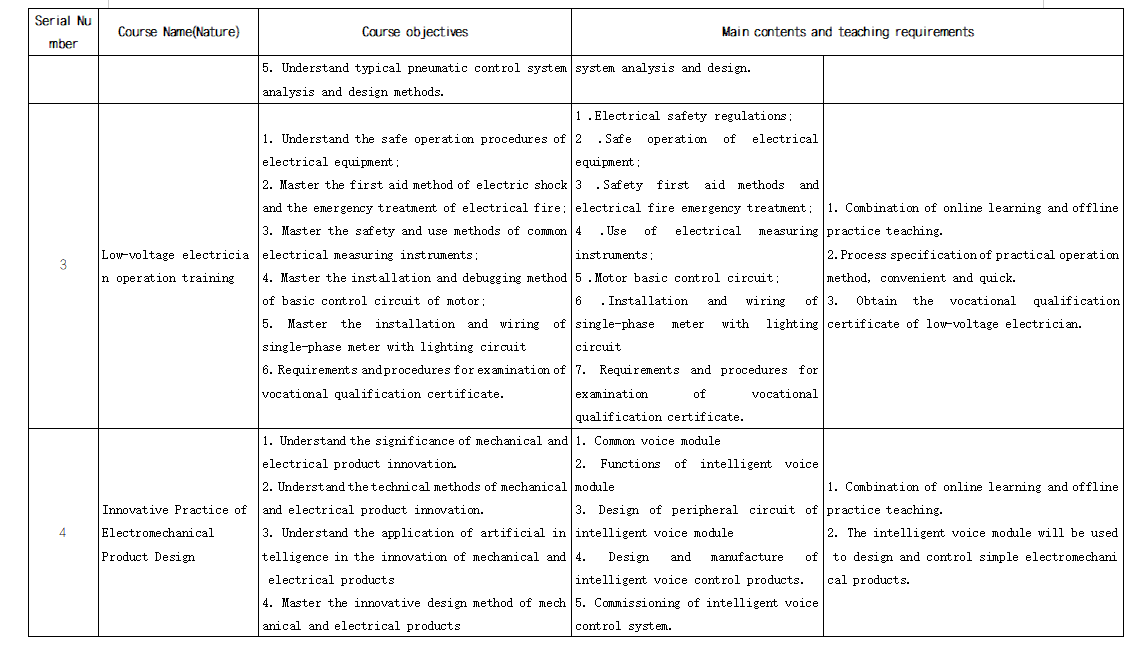
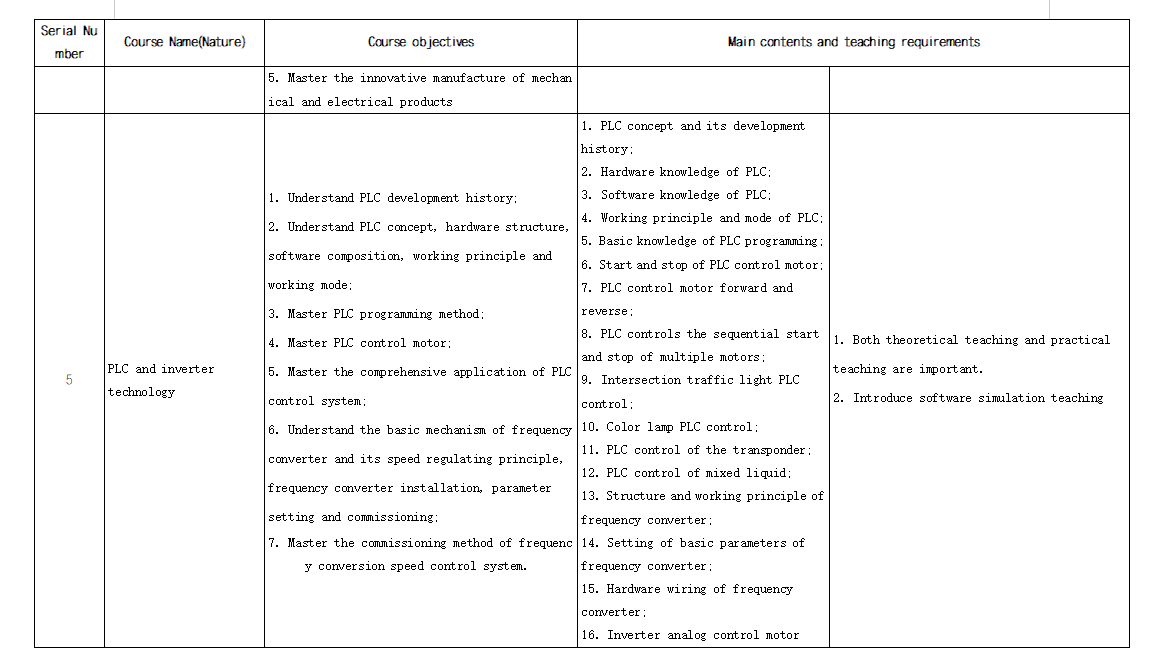

七、General arrangement of teaching process
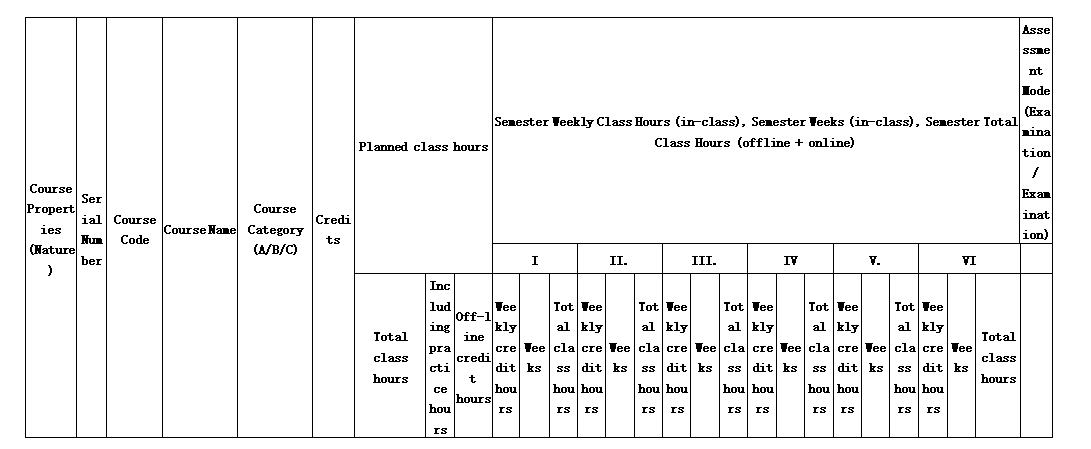
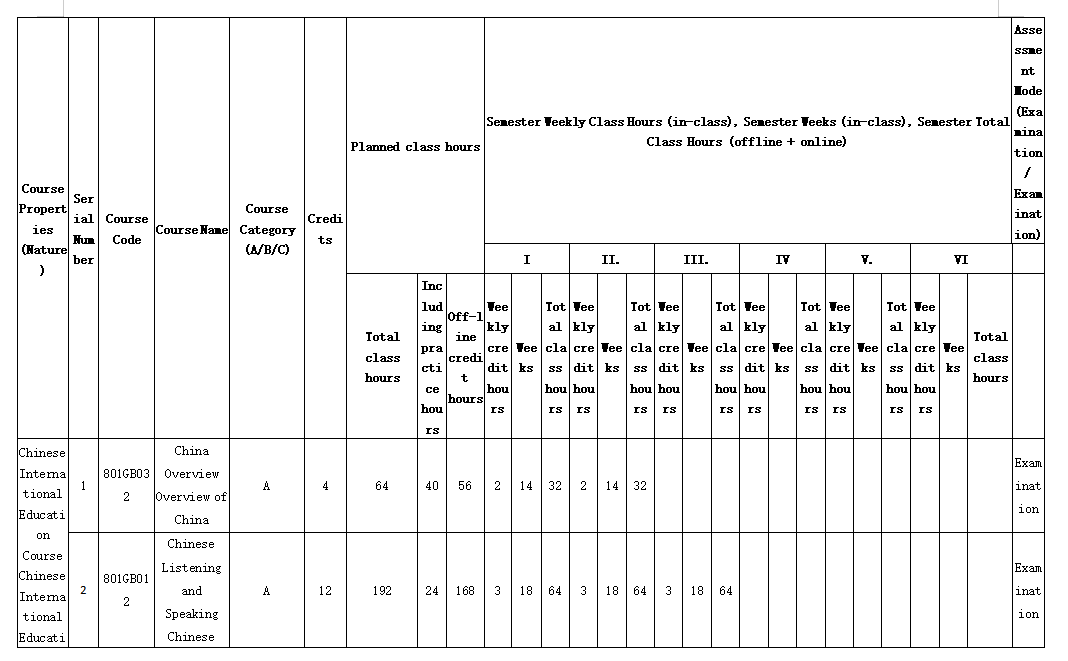
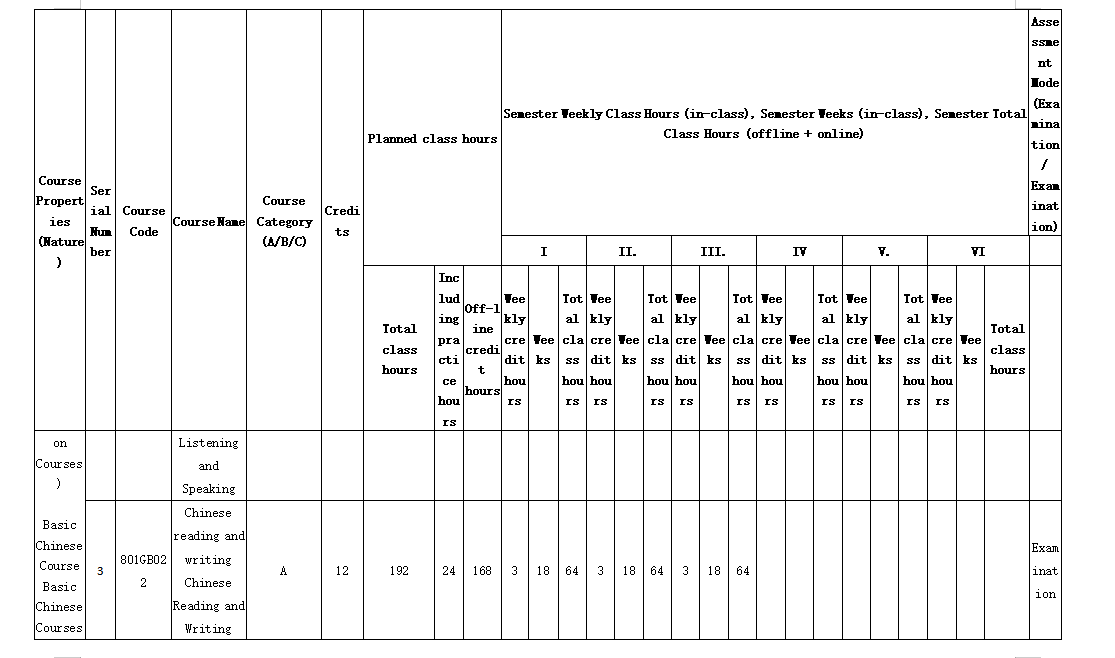
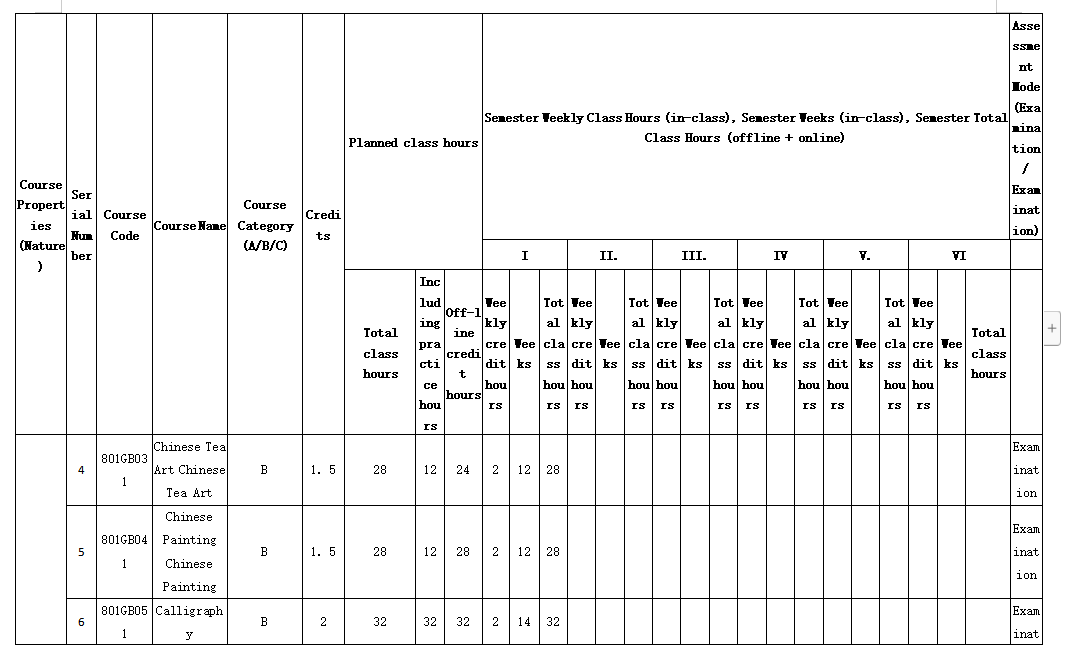

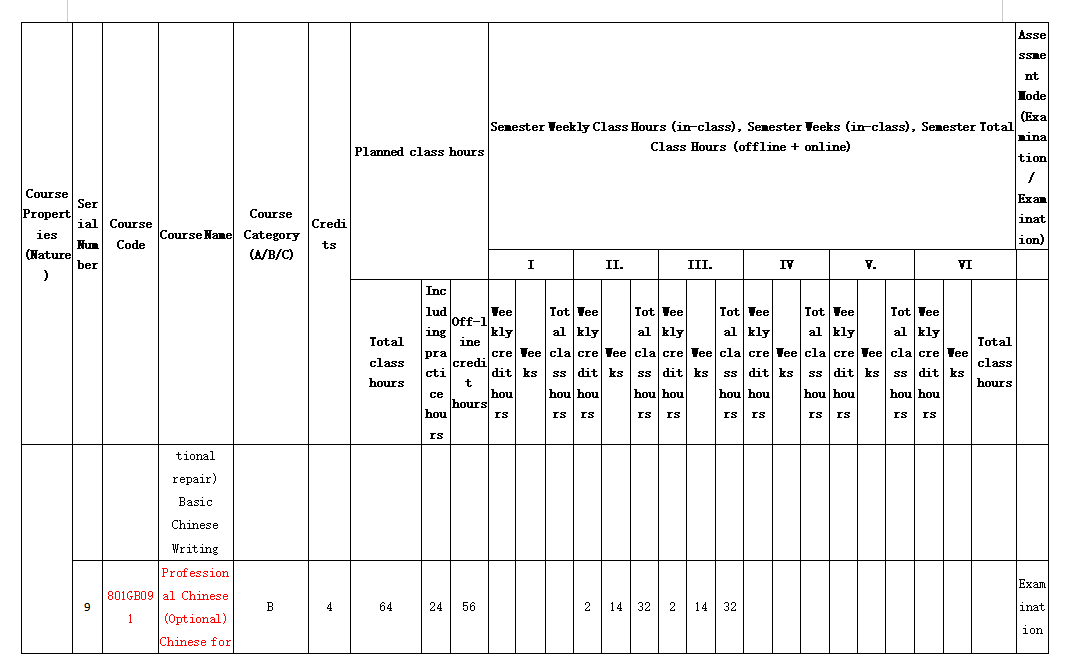
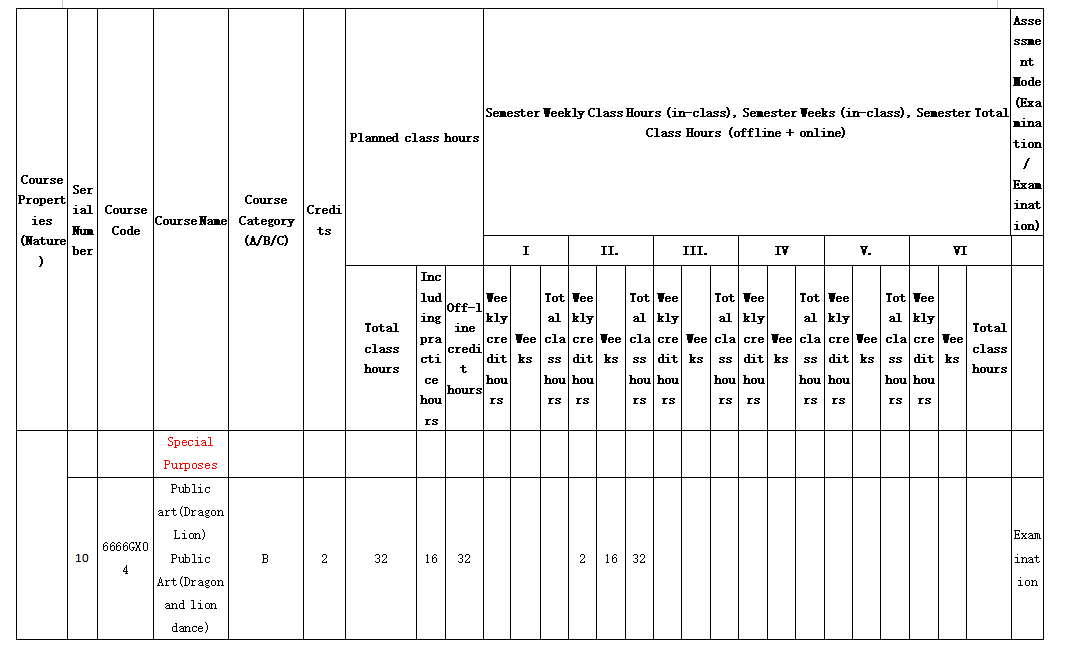
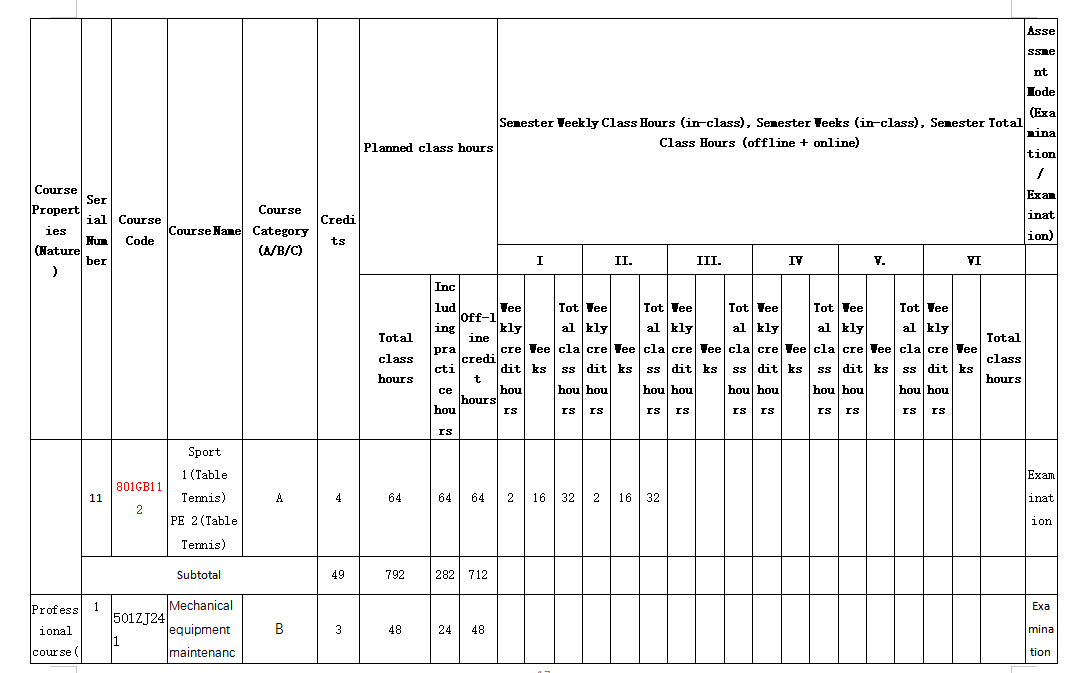
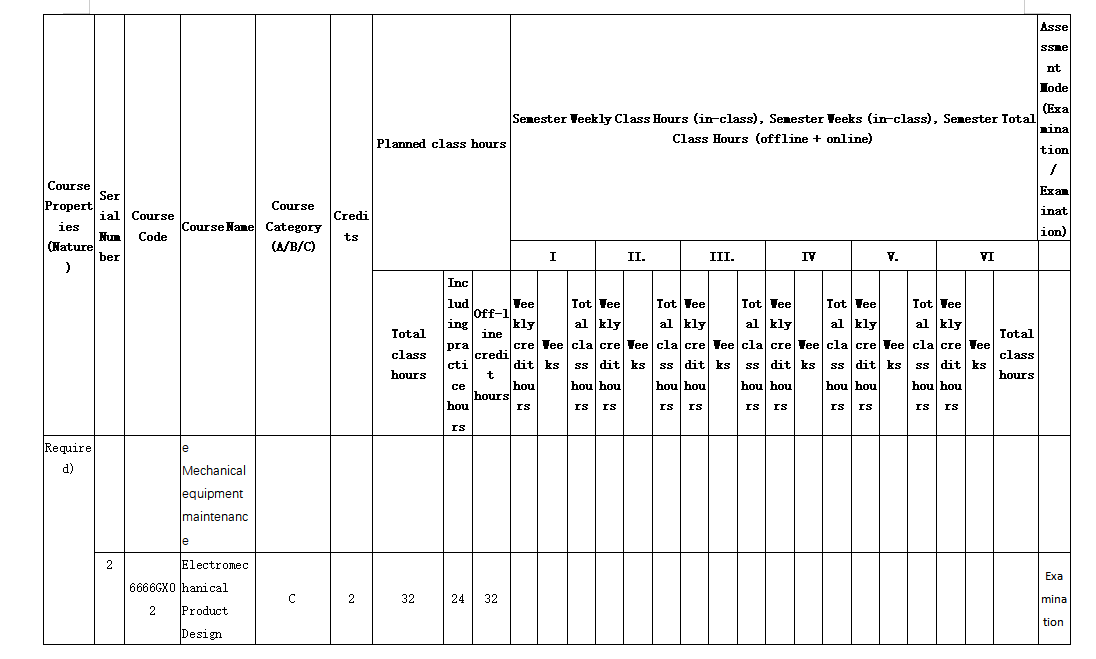
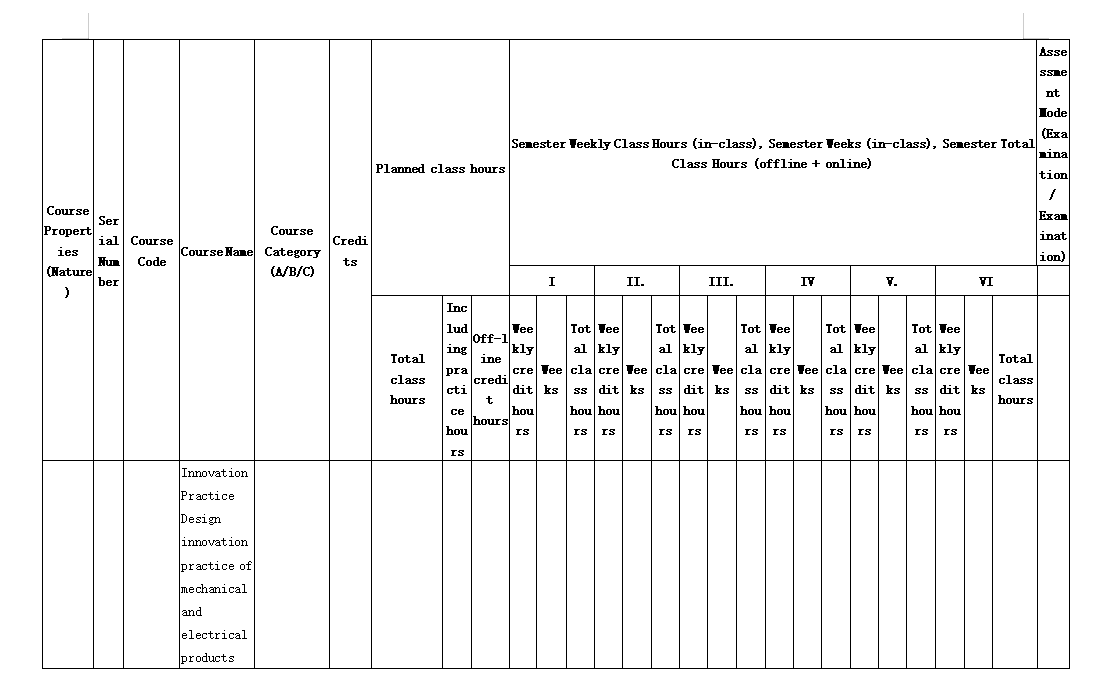
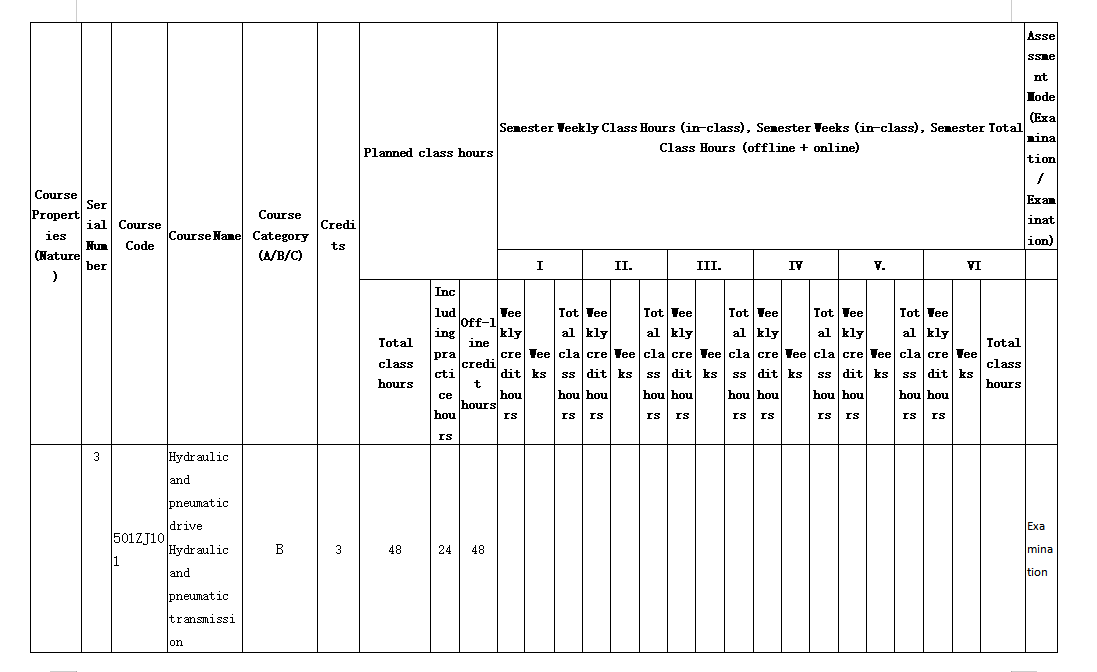
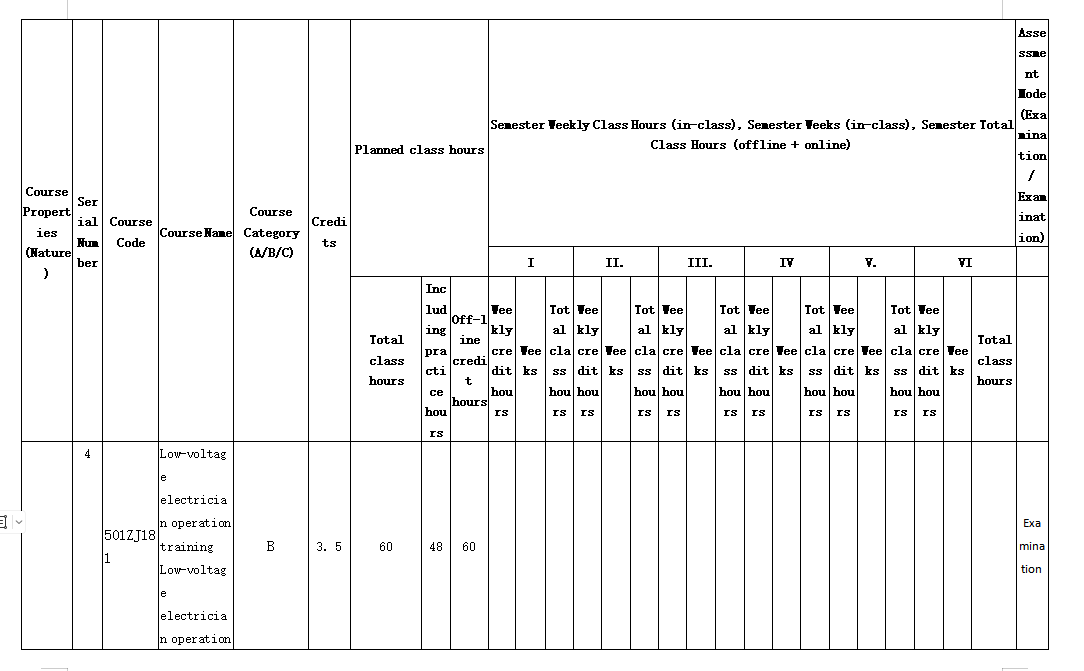
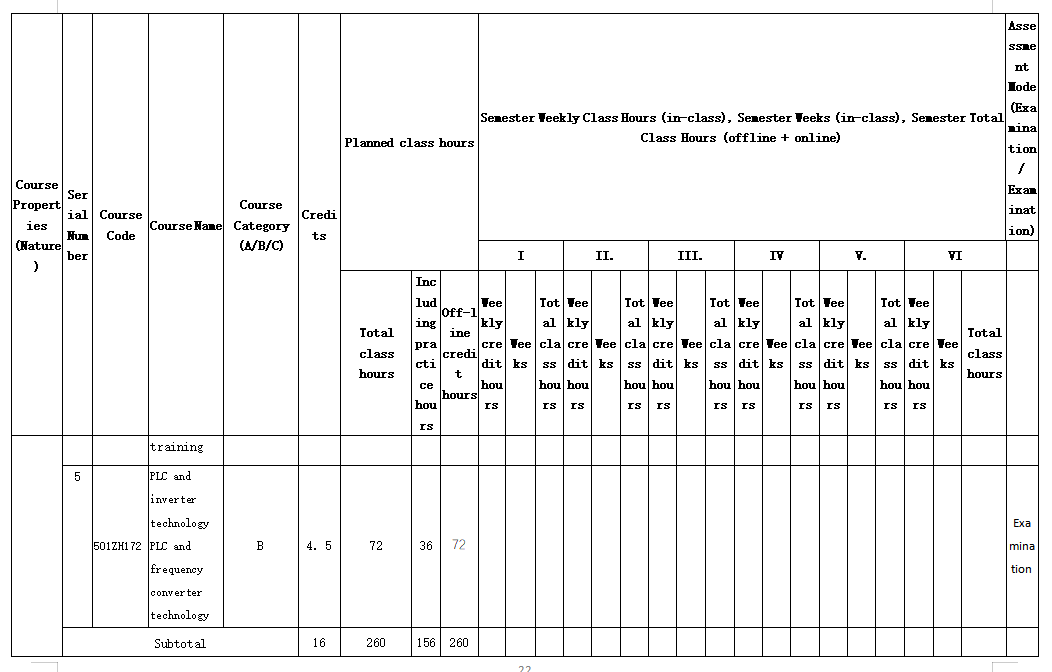
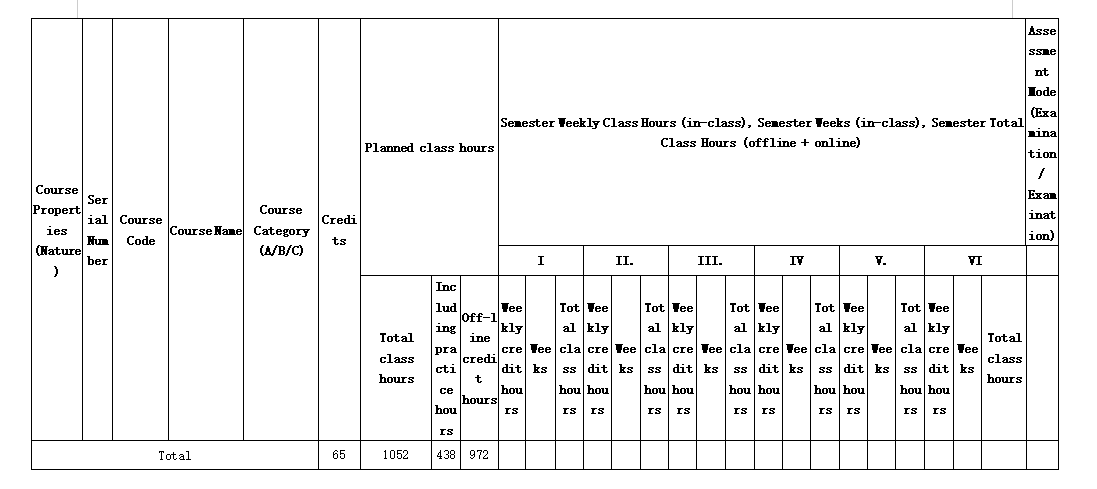
Note: 1. Mark <unk> refers to 1+X certificate system integration course.
2. Course category: A represents pure theory course, B represents theory + practice course, and C represents pure practice course.
3. Total course hours = sum of total semester hours; Total credit hours of semester = offline credit hours + online credit hours; Offline credit hours and online credit hours can include theoretical credit hours and practical training credit hours.
4. Some course descriptions:
(1) Physical education: Subject to specific conditions, published before class selection.
(2) Safety education: The contents of professional safety education shall be integrated into professional courses and practical training. Safety education shall be carried out before the commencement of each professional course, and safety education shall be carried out according to the actual situation.
(3) Design innovation practice of mechanical and electrical products: Students obtain credits by completing the practice of innovation projects, participating in innovation and entrepreneurship plan competition, submitting innovation and entrepreneurship plan works, etc.
(4) Limited courses for public art: Mainly as Dragon and Lion, Music Appreciation, Fine Art Appreciation, Film and TV Appreciation, Drama Appreciation, Dance Appreciation, Calligraphy Appreciation, Drama Appreciation can be studied in amateur according to their own interests.
(5) Only 5 professional courses are arranged, and other courses offered synchronously in this semester can be selected according to students' learning interests and abilities, and corresponding credits can be obtained by replacing them with credits.
VIII. Implementation guarantee
(I) Teachers
1. Professional construction guidance committee.
The main functions of the Professional Steering Committee are to determine the direction of professional construction and professional development, review and approve the professional talent training plan and professional teaching plan, guide the course system construction and teaching reform, hold meetings regularly and irregularly, discuss the professional construction and professional development, and review and approve the annual professional talent training plan and professional teaching plan.
List of Experts:
Enterprise expert: Li Xiuming, Luo Tianqing, Chen Chaowei, Lianqiwei Jinfei
Off-campus expert: Yang Quan, Ye Yuan, Jian Guo Ping
In-school expert: Long Danning Yuhe Xie Xiangqiang Chen Yan Li and Ming Huang Zhibin
Serial Number |
Name |
Committee position |
Work unit |
Unit position |
Title |
1 |
Yuhe |
Chairman |
Guangxi Electric Power Vocational and Technical College |
Director of Institute of Intelligent Manufacturing Engineering |
Associate Professor |
2 |
Yang Quan |
Deputy Chairman |
Guangxi Industrial Vocational and Technical College |
Director of Intelligent Manufacturing College |
Associate Professor |
3 |
Li Xiuming |
Deputy Chairman |
Guangxi Machinery Industry Research Institute Co., Ltd. |
|
Senior Engineer |
4 |
Longtannin |
Deputy Chairman |
Guangxi Electric Power Vocational and Technical College |
Deputy Dean, College of Intelligent Manufacturing Engineering |
Associate Professor |
5 |
Laoshenglin |
Deputy Chairman |
Guangxi Electric Power Vocational and Technical College |
Deputy Dean, College of Intelligent Manufacturing Engineering |
Professor |
6 |
Xie Xiangqiang |
Deputy Chairman |
Guangxi Electric Power Vocational and Technical College |
Professional leader |
Associate Professor |
7 |
Chen Yuyan |
Member |
Guangxi Electric Power Vocational and Technical College |
|
Associate Professor |
8 |
Li Heming |
Member |
Guangxi Electric Power Vocational and Technical College |
Professional leader |
Associate Professor |
9 |
Huang Zhibin |
Member |
Guangxi Electric Power Vocational and Technical College |
Professional leader |
Engineer |
10 |
Ye Yuanjian |
Member |
Minami Yui Ning Vocational and Technical College |
Teacher |
Associate Professor |
11 |
Guo Ping |
Guo Ping |
Guangxi Institute of Water Conservancy and Electric Power Technology |
Professional leader |
Associate Professor |
12 |
Chen Chao |
Member |
Guangxi Minami Yui sub-appliance |
Deputy general manager |
Engineer |
13 |
Luo Tianqing |
Member |
Guangxi Mori Hiroko Automation Technology Co., Ltd. |
Business Manager |
Engineer |
14 |
Wei Lianqi |
Member |
Minami Yui Ning City Intelligent Control Electric Technology Co., Ltd./Minami Yui Ning Vocational and Technical College |
Deputy General Manager |
Senior Engineer |
15 |
Wei Jinfei |
Member |
Aoshi Marina Dingxin Communication Co., Ltd.(Guangxi Regional Manager) |
Deputy General Manager of Hua Minami Yui District |
Engineer |
2. Faculty
The school-enterprise cooperation has jointly formed a structured teaching team of 19 teachers, including 10 full-time teachers (including professional leaders) and 8 teachers with double-teacher quality, accounting for 80%; The proportion of professional titles is "Senior: Deputy Senior: Intermediate: Junior": 0:5:5:0. See the following table for the basic information of team members:
Structure of Teacher Teaching Team
Category |
Name |
Title Structure(Person) |
Double-division type (Yes/No) |
Positive Advanced |
Sub-advanced |
Intermediate |
Primary |
Professional leader |
Xie Xiangqiang |
|
√ |
|
|
Yes |
|
Huang Quan |
|
√ |
|
|
Yes |
Li Heming |
|
√ |
|
|
Yes |
Chen Yuyan |
|
√ |
|
|
Yes |
Pan Zhi Minami Yui |
|
|
√ |
|
Yes |
Qinfeng |
|
|
√ |
|
Yes |
Huang Zhili |
|
|
√ |
|
Yes |
Area leveling |
|
|
√ |
|
No |
Chen Jianwei |
|
|
√ |
|
No |
Lin Zefeng |
|
|
|
√ |
No |
Forest leaf |
|
|
√ |
|
Yes |
Part-time teacher |
Yu Meifang |
|
√ |
|
|
Yes |
Zhannianyuan |
√ |
|
|
|
Yes |
Longtannin |
|
√ |
|
|
Yes |
Yuhe |
|
√ |
|
|
Yes |
Ye Yuanjian |
|
√ |
|
|
Yes |
Enterprise Technical Expert With skilled craftsmen |
Li Junzhuang |
|
|
√ |
|
Yes |
GanBinda |
|
√ |
|
|
Yes |
Qin Yaoyue |
|
|
√ |
|
No |
Luo Tianqing |
|
|
√ |
|
No |
Total |
19 |
1 |
9 |
9 |
1 |
|
3. Teaching facilities
(1) Basic information of in-school training room (base):
Serial Number |
Name of Training Room |
Station(Pieces) |
Name of main equipment |
Quantity of equipment(Set) |
Mainly undertake courses |
1 |
Fitter technical training room |
48 |
Fitter table |
48 |
Metalworking Practice |
2 |
Welding technology training room |
12 |
Manual arc welding machine |
12 |
Welding Practice |
3 |
Training room for machining technology |
12 |
Common lathe/drilling machine |
12 |
Machining Practice |
4 |
Mapping Training Room |
48 |
Drawing plate |
48 |
Mechanical Process and CAD |
5 |
Training room for maintenance fitter |
48 |
Mechanical maintenance equipment Fan and pipe valve |
16 |
Mechanical Equipment Maintenance Installation, Adjustment and Maintenance of Industrial Piping System and Equipment |
6 |
Hydraulic and pneumatic technology training room |
48 |
Hydraulic system training platform Pneumatic system training platform |
12 |
Hydraulic and pneumatic drives |
7 |
Electrical circuit installation training room |
48 |
Electrical control terminal block |
48 |
Electrical Control Circuit Installation and Commissioning |
8 |
Industrial configuration technology training room |
48 |
Computer |
48 |
Industrial Configuration and Touch Screen Technology |
9 |
PLC 1200 Training Room |
48 |
1200PLC Training table |
|
PLC and Frequency Converter Technology |
10 |
Industrial Robot Programming Training Room |
48 |
Industrial robot training equipment |
12 |
Programming and Commissioning of Industrial Robots |
11 |
Industrial measurement and control technology training room |
48 |
Single chip computer training platform |
20 |
Measurement and Control Technology of Single Chip Microcomputer |
12 |
Auxiliary control technology training room of thermal power plant |
48 |
Auxiliary control system/electrical control cabinet of thermal power plant |
1/12 |
Installation and Commissioning of Auxiliary Control System of Thermal Power Plant |
13 |
Siemens Automation Training Room |
48 |
Industrial control platform |
6 |
Siemens 1500 Industrial Control Technology |
14 |
Rockwell Automation Training Room |
48 |
Rockwell PLC Training Platform |
20 |
Rockwell Industrial Control Technology |
15 |
Basic Laboratory of Electronic Technology |
48 |
Electronic experimental equipment |
12 |
Electronic Technology |
16 |
Electronic Skills Training Room |
48 |
Electronic Skills Welding and Installation |
48 |
Electronic Product Making |
17 |
Numerical control installation and adjustment technology training room |
48 |
Machine tool fault queuing and maintenance |
4 |
Fault diagnosis and maintenance of electromechanical equipment |
18 |
Motion control training room |
48 |
Multi-degree-of-freedom motion control textual equipment |
4 |
Comprehensive training of motion control(1+X Certificate) |
19 |
Electrician confirmation training room |
48 |
LV electrician operation training room |
24 |
Low-voltage electrician operation training(Electrician certificate) |
20 |
Maintenance electrician training room |
24 |
Machine tool troubleshooting training equipment |
24 |
Electrical Control Circuit Installation and Commissioning |
Total |
20 counts |
864 counts |
|
|
|
(2) Basic information of off-campus training base:
Serial Number |
Name of off-campus training base |
Can accommodate interns(Person) |
Training project/content |
1 |
Jinjitan Hydropower Plant |
50 |
1. Power Plant Understanding 2. Maintenance of mechanical equipment 3. Maintenance of electrical equipment 4. Microcomputer governor control |
2 |
Guangxi Mori Hiroko Automation Technology Co., Ltd. |
50 |
1. Installation and commissioning of electrical control circuit 2. Industrial configuration design 3. Touch screen picture and PLC program debugging 3. PLC and frequency converter control commissioning |
3 |
Guangxi Minami Yui Electric Appliance Co., Ltd. |
50 |
1. Transformer structure 2. Installation and commissioning of distribution cabinet 3. |
4 |
Hitachi Elevator Guangxi Branch |
50 |
PLC application technology, frequency converter technology, sensor technology, post practice |
5 |
Ruisheng Technology (Minami Yui) Co., Ltd. |
50 |
Knowledge practice, industrial control network technology, PLC and inverter application technology, sensor technology, post practice |
Total |
5 counts |
250 persons |
|
4. Teaching resources
(1) Basic information of textbook selection:
According to the college textbook management regulations and relevant regulations, strictly control the ideological level, practically serve the talent training, give priority to selecting textbooks from the national and provincial level planning textbook catalogues, and cooperate with local industry enterprises to develop specialized course engineering manuals and loose-leaf textbooks with distinct characteristics.
(2) Basic information of quality courses:
This major has obtained two demonstration courses of thought and politics of self-government and obtained "Microcontroller Application Technology" and "Siemens 1500 Industrial Control Technology."
(3) Basic information of book equipment:
The current library of our institute has about 46, 7852 copies of paper books, 95 copies of books per student, and more than 23500 copies of professional-related books
(4) Basic information of digital resources:
The discipline is equipped with abundant digital resources, mainly in the form of PPT, pictures, videos, micro-courses, animation and simulation, with a total capacity of 90 G. Most of the major courses enable online learning of digital resources.
The college library has 5 databases (CNKI, Wanfang database, Wanfang database, Wanfang knowledge base and Wanfang examination system), two Goethe e-borrowers and a set of mobile library service platform. The electronic resources are converted into 1203909 books, including 162607 e-books, about 1769 .1 GB. 9753 e-journals.
5. Teaching method
Based on the installation, commissioning and maintenance of water system control equipment in the power plant and the assessment requirements of professional skills and other certificates in the pilot "Development and Application of Motion Control System" of the 1+X Certification System of the Ministry of Education, it mainly focuses on the installation, commissioning and maintenance of pump and fan equipment in the water system of the power plant, electrical control technology of pump and fan, frequency conversion control of pump motor, industrial network configuration, configuration and touch screen control technology, stepper motor and drive control, servo motor and drive control, course development and learning situation construction based on work process, which is consistent with the process of work process and engineering construction. There are clear engineering curriculum standards and procedures. The teacher shall actively carry out discussion-type, case-type and situation-type teaching according to the characteristics of the students, combine the course teaching with engineering practice, construct and effectively operate the mode of "alternating project teaching of work and study," and integrate "teaching, learning and doing" into the role play and team cooperation of the students.
6. Learning evaluation
1. Evaluation mode
Combination of result evaluation and process evaluation; Combination of individual evaluation and group evaluation; Theoretical learning evaluation is combined with practical skill evaluation, and quality evaluation - knowledge evaluation - ability (skill) evaluation is equally important.
2. Evaluation method
Establish diversified evaluation methods. Written examination, observation, oral examination, on-site operation, submission of case analysis report, workpiece production, professional skill examination and skill competition, course works, etc., and overall and process evaluation.
Grade assessment is the basic assessment for students to complete their teaching tasks. The combination of qualitative assessment and quantitative assessment must be adhered to, and comprehensive assessment shall be carried out mainly with skill assessment. During the teaching assessment, try to highlight the cultivation of students' "professional ability," actively carry out the reform of assessment method focusing on practical ability assessment, and improve students' practical ability and employment competitiveness.
The specific suggestions for the course of integration of theory and practice are as follows: Theory examination accounts for 40%; Practical operation examination 45%; Learning attitude, discipline, attendance, safe and civilized production and group cooperation, accounting for 10% of the comprehensive achievement; Qualification 5%.
7. Quality management
Establish and improve the two-level teaching supervision mechanism, and implement the guidance, assistance and management of the whole teaching process; Establish a system of listening to classes and guide teachers to improve teaching ability and classroom teaching quality; Establish a course construction team to optimize the course teaching design. The professional core course construction team will carry out project approval research as a teaching reform project to ensure the quality and standardization; Establish a perfect incentive and restraint mechanism to fully arouse teachers' enthusiasm and initiative to participate in teaching reform. Improve the teaching management mechanism, strengthen the daily teaching organization and operation and management, establish and improve the system of course patrol, course listening and teaching evaluation, establish the supervision system of practical teaching links, and make strict teaching discipline. Improve the diagnosis and improvement system of professional teaching, improve the monitoring and evaluation mechanism of professional teaching quality, strengthen the construction of quality standards in classroom teaching, practice training, graduation design and post practice, and improve the quality of education and teaching. Improve the academic level test, comprehensive quality evaluation, graduate quality tracking and feedback mechanism and social evaluation mechanism, and regularly evaluate the talent training quality and achievement of training objectives. Carry out research on characteristic specialties and courses of similar colleges and universities, constantly strengthen the top-level design of specialties, and establish a normal diagnosis and improvement mechanism for quality assurance of specialties (courses).
Compulsory Professional Qualification Certificate Assessment Schedule

IX. Graduation Requirements
Students of this major must meet the following conditions for graduation and be granted with the college diploma recognized by the State:
Students shall complete all compulsory courses specified in the teaching plan of the major and elective courses within the specified scope within the specified years of study, and obtain at least 89.5 credits through examination (examination), of which the compulsory courses shall not be less than 71.5 credits, and the elective courses shall not be less than 18 credits.
At least one occupational skill certificate of relevant technical work type of the discipline including 1+X certificate, passing the graduation examination;
3. Comply with relevant regulations of higher vocational school registration management.
X. Characteristics of Talent Training Mode
Focus on the relevant industry fields of the discipline, cultivate the training goal of compound international technical and skill talents with innovation consciousness, strengthen the cooperation with the manufacturing industry enterprises, realize the joint education of the school and enterprise, deepen the integrate the resources of enterprises with vocational schools and universities, adjust and improve the professional course system, develop the course teaching resources, and formulate the talent training mode of "post-course license creation" in combination with the professional post requirements by taking the work process of the professional posts such as automatic control engineering technicians, electrical and electrical engineering technicians and equipment engineering technicians. “Class "represents the training of professional talents, is the core; "Post" highlights the enterprise demand and reflects the combination of work and study; "Certificate" represents the requirement of occupational position and is the standard; "Competition" represents the major competition of vocational skills, which is the grasping hand; "Innovation" represents the cultivation of innovative thinking and entrepreneurial ability, which is the improvement of literacy. “The "Creation of Post-course Certificate Competition" is a mutual accommodation, deepening the dual-subject education of schools and enterprises, cultivating the core skills and quality of students, and possessing the characteristics of modern vocational education.
“2+1.5”联合培养项目国际学生课程设置与教学进程表(机电一体化技术专业)
Curriculum and Teaching Schedule for International Students in "2+1.5" Joint Training Program (Mechatronics Technology major)
